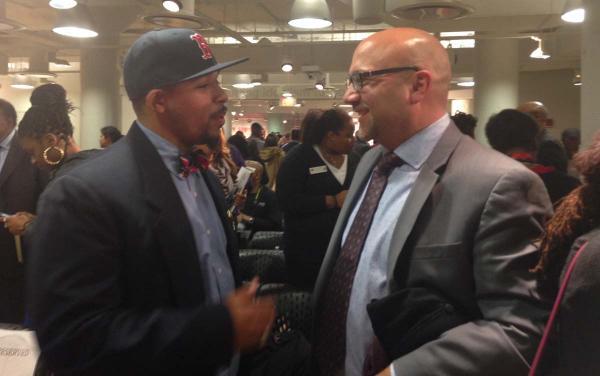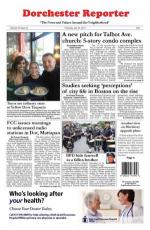November 19, 2014

State Rep. Jeffrey Sanchez (D-Jamaica Plain), right, spoke during an event at City Year last week in which a new report detailing disparities for black and Latino boys was released. Photo by Eliza Dewey
A new report on how black and Latino male students are doing in the Boston Public Schools points out stark racial disparities in educational opportunities and outcomes, assertions that have elicited promises of improvement from officials and expressions of frustration from others.
Released last Thursday, the report, entitled “Opportunity and Equity: Enrollment and Outcomes of Black and Latino Males in Boston Public Schools,” was commissioned by former Superintendent Carol R. Johnson in 2010 and produced by the Boston Public Schools in conjunction with the Center for Collaborative Educative and the Annenberg Institute for School Reform at Brown University.
The study uses data from 2009 to 2012 to analyze both the diversity within the black and Latino male student population and the disparities between these students as a group and their white and Asian peers with regard to access to opportunities and rates of educational attainment.
Black and Latino students make up almost 78 percent of the total male student enrollment in the Boston Public Schools system.
The study separates out black students based on birth in North America, the Caribbean or Africa, and Latino students based on birth in North America, the Caribbean, Central America or South America. Recognizing that “Latino” is not treated in the United States as a distinct racial group, that population is also split into three racial categories: white, black, and other.
Dan French, the executive director of the Center for Collaborative Education, acknowledged during his presentation of the report that the categorization metric was a source of much debate during the design of the study and will continue to be a talking point.
Still, said Christina Mokhtar, the principal research associate, the report provides “a deeper understanding of diversity within black and Latino male students, uncovering a more nuanced story…rather than the typical treatment of them as homogenous groups.”
Many of those responding to the report focused on its second half, which examines the differences in educational opportunities and attainment that fall along racial lines in terms of attendance rates, suspension rates, dropout rates, MCAS scores, and graduation rates. The finding there is that while there are recent positive trends for male students across the board, black and Latino males are most at risk of low attendance, low MCAS scores, being suspended, and dropping out of school.
While these differences in outcomes are not news, the report takes an in-depth look at disparities in access to programs within the Boston Public School system that it says are fueling the problem and highlights four main areas:
• The type of environment in which students with special needs are educated (are substantially separated from their general education peers or not?);
• Placement in the Advanced Work Class (AWC) program, which is based on a student’s performance in the third grade;
• Admission to one of Boston’s three exam schools (Boston Latin School, Boston Latin Academy, and the John D. O’Bryant School of Mathematics and Science), which is greatly influenced by a student’s prior enrollment in the AWC track;
• Completion of the MassCore Curriculum, a process developed by the state Department of Education to prepare high school students for college and/or the workplace that is not required or universally offered, but recommended.
The study found racial disparities across all these indicators. Dan French summarized the findings by saying it showed students are “sorted as early as third grade into two tracks,” one of which offers a much greater potential for educational and career success.
Those who spoke at the Thursday event reacted most vigorously to the notion of the “two tracks.” Rahn Dorsey, the chief of education for the city of Boston (a newly designed position within the Mayor’s Cabinet), described that finding as a “blunt characterization” that provided an impetus for action. Miren Uriarte, a professor at UMass Boston and a member of the advisory committee for the report, said that while much of the report’s findings were “not news” for her, she was surprised by the documentation of “a do-or-die moment at age eight” when decisions about AWC placements are made. Warren Simmons, executive director of the Annenberg Institute, added, “you cannot have a successful system that produces underperformance in 40 percent of its students.”
In an emotional and impromptu speech, state Rep. Jeffrey Sánchez (Mission Hill, Jamaica Plain, Roslindale) described his frustration at the fact that the Boston Public Schools still were experiencing such disparate outcomes between black and Latino boys and their peers of other racial groups.
“I’m saddened, I’m angered and I can’t believe we’re at this point now,” he said. “[Boston] is the Athens of America, the beacon of liberty, and this is what we have to offer?” He added that he felt a sense of personal responsibility for the state of things. “I’m a part of this failure…I feel like I’m looking in the mirror right now, and I look really ugly.”
Mayor Martin Walsh stressed his commitment to the issue. He recounted an incident in which someone warned him that the conversation regarding race and outcomes in the school system “could get ugly.” He said he responded, “This conversation needs to happen.” He added, “I didn’t run for mayor for the status quo. I ran for mayor to make a difference.”
Walsh went on to described the city’s involvement with President Obama’s “My Brother’s Keeper” initiative, which seeks to improve life outcomes for boys and men of color, as “an opportunity for Boston to be a leader in the movement.” He added that he had received some feedback from advocacy groups who were concerned that girls, especially black and Latina girls, were being left out, and said his administration will address their issues as well.
Although Michael O’Neill, Chair of the School Committee, missed the report launch due to a scheduling conflict, interim Superintendent John McDonough read a statement from O’Neill that described the issue as “a priority to the School Committee.” McDonough added for himself that the report “will be required reading for any candidate who wants to be the next superintendent.”
Hubie Jones, a senior adviser to City Year and a longtime civic activist and social entrepreneur in the Boston area, took the occasion to place the study in historical context. After recounting some of Boston’s troubled history regarding race in its schools – including tensions between the NAACP and the School Committee in the sixties, busing in the seventies, and “white flight” thereafter – he said the report had special significance because it was commissioned by the school system itself. “The long era of denial is over,” he concluded.
Jones offered praise of current leaders for their dedication to the issue, noting Mayor Walsh determination to introduce universal pre-kindergarten and Superintendent McDonough work in ensuring “a diverse teaching force.”
Ron Walker, executive director of the Coalition of Schools Educating Boys of Color, stressed the importance of key players acting on the report’s findings. “I don’t need to see one more report – and neither do you. What you need to do is act,” he told the audience. Alluding to the sentiment of tempered hope that seemed shared by many in attendance, he added, “We need to do this for those young people looking at us and saying, ‘Are you really serious this time?’ ”
In a phone interview after the meeting, Lindsa McIntyre, principal of the Jeremiah E. Burke High School in Dorchester, said that she was “excited” to see the report because it was “long overdue.” While saying it provided an important look at the data, she wondered about the next step in the process.
“How will we work it down to the classroom level?” she asked. She also highlighted areas in which her school has already begun to take a serious look at the barriers faced by its students, including a specific look at black and Latino male students.
The Burke has several relationships with community agencies and institutions that provide a network of mental health services for a student population with a high degree of history of trauma. The school has also changed its approach to discipline as administrators have learned the extent to which behaviors typically misinterpreted as “acting out” are generally reactions to emotional stress.
McIntyre says the school’s number of suspensions has dropped from 525 four years ago to just 38 during the last school year. “We’re vocal about stopping the school-to-prison pipeline,” she added. Another sign of hope: Last year the school had the third-highest growth in the Boston Public Schools in its MCAS math scores.
•••
In related news: On Monday Mayor Walsh vetoed a City Council proposal championed by City Councilor Tito Jackson to create a commission in the Mayor’s office that would focus on Black and Latino men and boys. In a letter made public, Walsh said that the proposed commission would “duplicate and complicate efforts that my administration is already involved in.” The mayor’s initiative is being led by Felix G. Arroyo and John F. Barros. The next community meeting for that group is scheduled for Sat., Dec. 6 at 9 a.m. at the James P. Timilty Middle School, 205 Roxbury St., Roxbury.
Topics:



